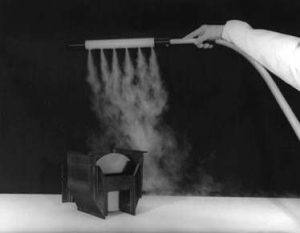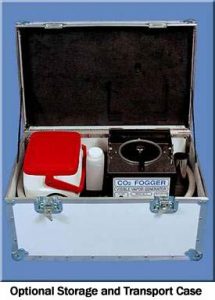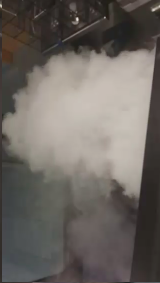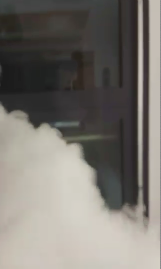CO2 Fogger
Description
CO2 Fogger– Request a Quote
- Clean room laminar flow testing
- Airflow balancing
- Wet bench exhaust optimization
- Process equipment ventilation testing
- Personal safety exhaust verification
- Pressure balancing between rooms and spaces
CO2 Vapor Fogger, 3cfm – Request a Quote
The CO2 Fogger is used to visualize airflow, turbulence and velocity patterns in your clean rooms. The fog is produced using a 1 lb. block of dry ice placed in a pre-heated, DI water reservoir. The CO2 fogger is often referred to as a Smoke Generator or Clean Room Fogger, but isNOT an “On Demand” fogger. Once the Fog process has started, it will continue to produce fog, 6 cfm at first, then decreasing down to 0 cfm as the dry ice is evaporated. The water can be heated outside the ISO suite, power disconnected, drop in the CO2 ice, then carry the CO2 fogger to the area to be tested. The Optional Fog Wand wand is designed to adjust for the type of fog dispersed from the wand, e.g., jet fog (left photo) or curtain fog (right photo). Simply sliding the end of the wand will select the desired fog pattern.
![fogger[1] Co2 Fogger](https://cleanroom-fogger.com/wp-content/uploads/2017/12/fogger1-300x233.jpg)

Features
- The CO2 Fogger, Smoke Machine is used in clean rooms and Pharmaceutical ISO suites as a multipurpose analytical tool for visually monitoring airflow characteristics in clean rooms and other spaces.
- The unique wand allows three different fog patterns to be generated: curtain fog, cloud fog and jet fog,
- Compact with less than one cubic foot in size.
- Portable and easily carried into the tightest spaces to perform airflow tests.
- Weight is about 26 lbs. (57.2 KG) with water and dry ice.
- CO2 Fogger can be used in the Class 100 – Class 10,000 spaces.
- Clean Room Facility staff like to use the CO2 Fogger to video the airflow visualization.
Features
- The CO2 Fogger, Smoke Generator is used in clean rooms and Pharmaceutical ISO suites as a multipurpose analytical tool for visually monitoring airflow characteristics in cleanrooms and other spaces.
- The unique wand allows three different fog patterns to be generated: curtain fog, cloud fog and jet fog. No other fogger has this feature.
- Compact with less than one cubic foot in size.
- Portable and easily carried into the tightest spaces to perform airflow tests.
- Weight is about 26 lbs. (57.2 KG) with water and dry ice.
- CO2 Fogger can be used in the Class 100 – Class 10,000 spaces.
- Clean Room Facility staff like to use the CO2 Fogger to video the airflow visualization.
Applications
- Clean room laminar flow tests
- Airflow balancing
- Wet bench exhaust optimization
- Chemical process equipment ventilation tests
- Personnel safety exhaust verification
- Pressure balancing between rooms and spaces
- Leak detection in ducts
![co2[1]](https://cleanroom-fogger.com/wp-content/uploads/2017/12/co21.jpg)

![icemaker[1]](https://cleanroom-fogger.com/wp-content/uploads/2017/12/icemaker1.jpg)
CO2 Vapor Fogger FAQs
- The CO2 Smoke Generator and Clean Room Fogger works on the principle of combining dry ice (solid carbon dioxide) with heated, ultra-pure (DI) water in a hard anodized heating chamber to produce a non-contaminating fog. The fogger is protected by over-temperature sensors and can be run dry without harming the equipment.
- CO2 in normal (lack of high heat) conditions is stable, inert and non-toxic.
- The average atmosphere, including cleanrooms, contains ~3.3% CO2.
- The average person exhales 5.5% CO2.
- The CO2 used in the Fogger is the same CO2. It is not in particle form. There are no carbon particles, nor any residue left from contact with the vapor.
- CO2 ice is produced in the dry ice block maker can be purchased as pure as 0.98%.
- CO2 is used in many specialized ultra-pure cleaning applications in the semiconductor and other industries.
- No, disinfectants or other additives cannot be added to the water.
- No, this CO2 fogger is not intended to eliminate insects or pests.
Notes:
- The fog generated by this device contains microscopic droplets of DI water. AVOID USING IN
IMMEDIATE VICINITY OF ELECTRICAL APPLIANCES, WATER SENSITIVE PRODUCTS AND EQUIPMENT.
Specifications
| Dimensions | 12.25 x 11.75 x 11.5 inches |
| Weight (including water) |
24 lbs. |
| Liquid capacity | 1 L |
| Fog Distance, Fog Volume | 6-7 feet distance, 8cfm maximum at start then decreases, average 4cfm |
| Fog Duration | 8-10 minutes |
| Power Supply | 120VAC, optional 220VAC |
Which Clean Room Fogger or Smoke Generator Is Best For My Applications?
* Use Hand Gloves and Face Shield when filling LN2 |
16 Meg ohm DI water is standard, but 64 Meg ohm can be used as well |
Fogger Technology
The three types of foggers manufactured for use in the semiconductor and pharmaceutical industry are described below.
Ultrapure LN2 Fogger: This type of smoke generator or clean room fogger provides the highest volume, density and purity of fog. Purity is created by bringing the water to a high temperature, creating a vapor, while simultaneously using gravity to remove the residual mass from the vapor. This process removes any bacterial agents and residual particulate matter from the vapor. The pure vapor is then passed over an LN2 bath, which naturally boils at room temperature. The water molecules bond with nitrogen molecules, creating a nominal 3um fog droplet. The volume of water and nitrogen molecules that combine is extremely high in quantity, creating a dense, high volume, ultrapure fog output with exit temperatures of about 78 degrees F with an exit pressure of less than 0.5 lbs, so as not to disturb the surrounding airflow. The fog is ultrapure leaving minimal, if any, trace particles behind. It evaporates to its gaseous hydrogen, oxygen and nitrogen components, which are natural to the Cleanroom environment. The high density of the fog increases the duration and travel distance of the fog. This fogger can be used in a Class 1 – 10,000 cleanroom environments of pharmaceutical and semiconductor facilities; such as sterile rooms, hospital rooms, medical rooms and cleanrooms.
DI Water Fogger: This type of fogger has less fog density (less capability to visualize airflow) than the UltraPure Fogger described above, but more density than the CO2 fogger described below. The DI water fog is generated by atomizing DI water into water droplets, which are nominally 3-10um in size. The water droplets may contain residual particulate matter remaining in the DI water, but this would be very trace amounts. If the facility manager operates a class 10 to Class 10000 Clean room, the use of a DI Water Fogger poses no problem. However, Cleanroom Engineers who manage facilities operating at Class 1 to Class 10 performance may desire to use an ultrapure fogger. Although some DI Water foggers are described as ultrapure, unless the DI water is vaporized to remove bacterial agents and residual particulate matter, the fog is not ultrapure. The 3-5lb output pressure of a DI water fogger also distorts the airflow patterns, thus adding to the turbulence. The temperature output is typically less than the surrounding room temperature, thus a fog generated from the atomized water droplets will sink momentarily in a typical 70 degree room temperature.
CO2 Fogger: This type of smoke generator or CO2 Fogger is designed for low volume, non-process critical applications such as bench airflow testing. The fog is created using CO2 ice as the fogging agent. The fog contains elements of the CO2 and the user must determine if the residual CO2 components are acceptable in a process environment operating Class 100 to Class 10,000. The 3-5lb output pressure of a CO2 fogger also distorts the airflow patterns, thus adding to the turbulence. The output starts at about 3cfm and slowly decreases to 0 CFM in about 10 – 12 minutes.
Smoke Sticks
Smoke Sticks are used in some Pharmaceutical Clean Rooms around the world. Below is a discussion on the use of smoke sticks used to visualize airflow and turbulence?
A smoke stick is often used visualize airflow turbulence, but smoke sticks are filled with particulates and chemicals. Smoke is created using chemical reactions; thus the smoke is SPUTTERING (sputter) or popping out of the smoke stick in a non-consistent pattern with velocity, but little volume. It is a particle smoke, compared to a visible, pure water based fog, thus smoke sticks are a contaminating smoke. The smoke stick generates an inconsistent flow or pattern of smoke, but it is low cost, which is why some managers allow use of smoke sticks in their Pharmaceutical clean rooms.
Compare a smoke stick to a Clean Room Fogger or an UltraPure LN2 fogger, both which produce a constant volume of fog with a consistent fog output and pure fog. Di Water foggers produce a consistent flow of visible water vapor, which enters the airflow to visualize the airflow patterns and turbulence, then begins to evaporate, returning back to the hydrogen, oxygen and nitrogen components that we breathe. No particulate contamination, no chemical contamination. Water based foggers produce a constant volume of fog at a constant rate, which provides consistent visualization of airflow patterns and turbulence. The Smoke Stick has to be waved around to see what kind of airflow pattern there is, while a Di Water fogger is simply placed in position and produces a flow of fog that can be directed 360 degrees to easily describe the airflow patterns and turbulence. In addition, tubes are now available to create “fog curtains”, or a wall of fog, which smoke sticks can not produce.
How many smoke sticks are used per smoke cycle? How much labor is needed to clean up after smoke stick use. Do you need to Clean all the walls where the smoke stick was used. How did the chemical particulates and particles affect the process area? These are critical questions for a pharmaceutical manager. Did the contaminating particles and chemicals get into the drug process?
How much labor is used to cleanup after smoke stick use and if the cleanup did not get every chemical particle, then some smoke chemical material is added to the Pharma process or trapped in a filter somewhere, until it escapes into the Pharma process. That is a quality control issue for that company using smoke sticks.
The low labor cost of using smoke sticks is the reason facility managers may use smoke sticks, but are the chemical and particulate effects to the pharma process being analyzed? Non-contaminating fog does not emit particulates, requires less labor and does not contribute any unwanted chemicals to the Pharma process. A Di Water Fogger provides these advantages in fog volume, fog consistency and fog purity, which easily outweighs the low cost of smoke sticks, the high cost of labor for cleanup and the detrimental affects to quality control!
Smoke Sticks – quality side of the drug product: The smoke chemicals are not of the same chemistry as the drug product, thus smoke chemicals and particulates could migrate into the drug process. There is no guarantee the cleaning process removed all the unwanted particulates and chemicals, from for example, a glove box or isolation box. The chemicals and particulates eventually migrate to the air filter system, which is not 100% effective. If this is the case, the quality and purity of the drug process is affected. Drug quality is the basis of product credibility, which is a valuable asset in customer relations.
Smoke Sticks – labor side of the drug product: The smoke is generated by a chemical reaction, which causes the smoke to sputter into the environment. The smoke is inconsistent in volume, thus the smoke stick is unpredictable for airflow visualization. The chemicals migrate to equipment and walls, which then must be cleaned, and requires an added labor cost. The use of Smoke sticks generates an inefficient smoke, not a consistent fog.
A Di Water Fogger produces a water (H2O) droplet that evaporates back into hydrogen and oxygen, the air we breathe. No clean up is required, at all. No additional time delays and clean up labor is not required. The fog is consistent in volume and constant in output to describe the airflow patterns and turbulence. These are equipment, quality and application concerns to consider when the need for airflow visualization is considered.











